I’ve been making no-knead homemade artisan bread for the last 15 years, and it’s always been good but never quite what I hoped it would be. It just wasn’t quite right.
Of course, it was still delicious, and we enjoyed the homemade bread, but it always left me thinking it could be better.
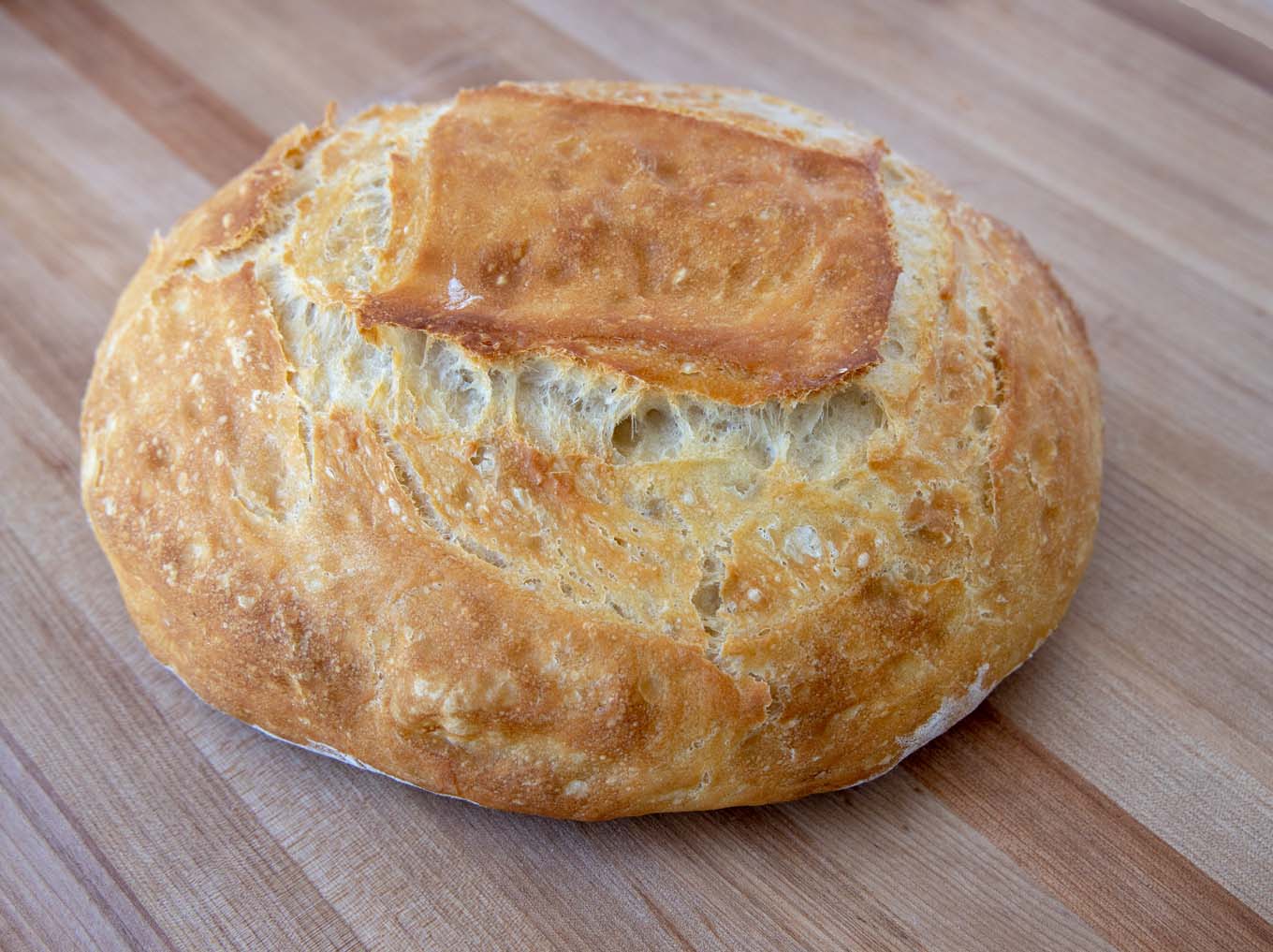
I’ve experimented with different quantities of yeast and salt. I’ve added sugar, honey, and other types of flour to the recipe in my quest for the perfect no-knead bread recipe.
One day, I was watching a sourdough bread video. It was way too much work for a loaf of bread, but the technique used to knead the dough intrigued me. So, I thought I would try that method with my much easier-to-make no-knead bread recipe.
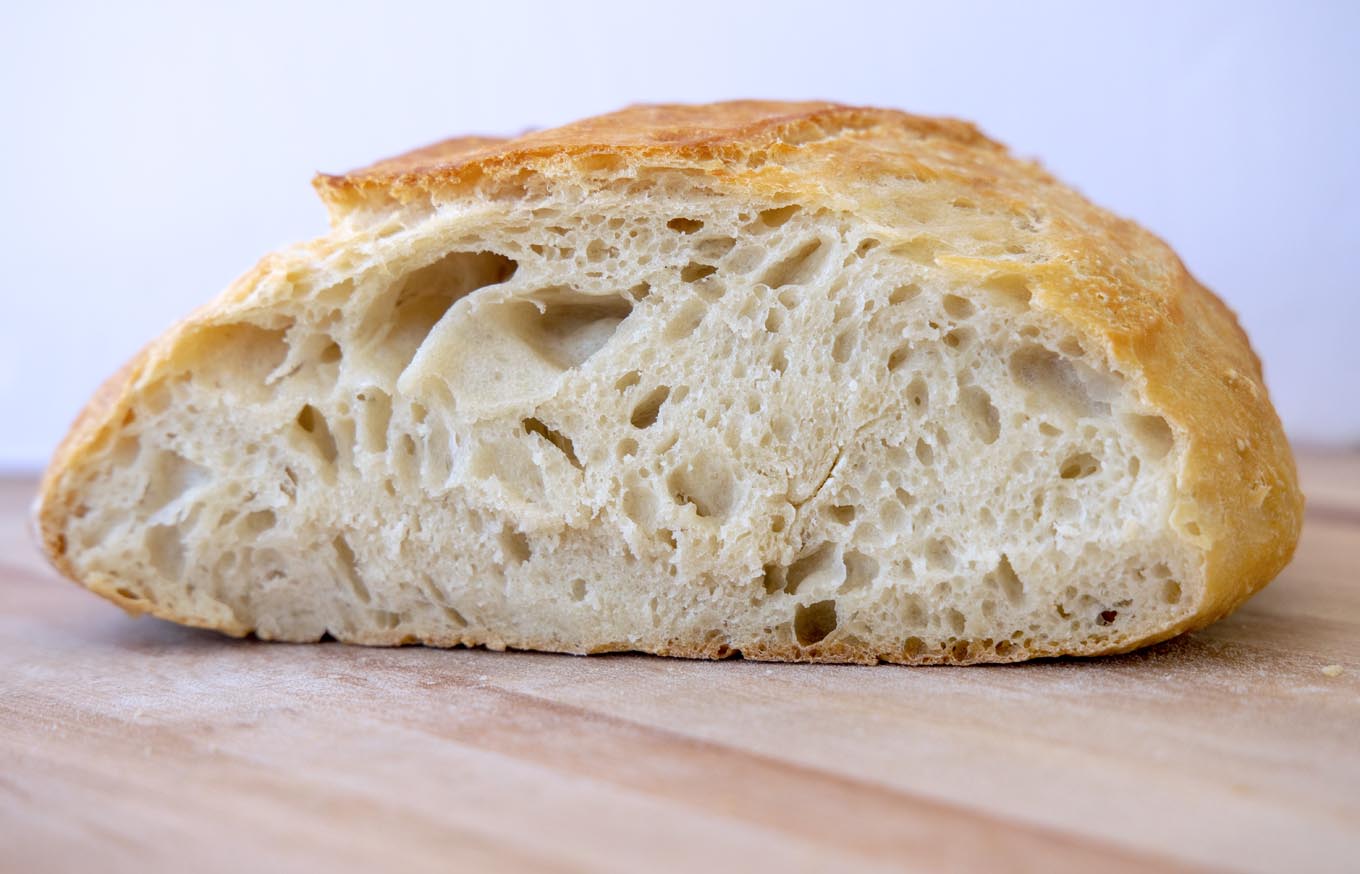
And it was amazing! The results finally yielded the bread I’ve been hoping to make for the last 15 years. It does require a small amount of kneading, but it’s pretty darn easy to make.
See all those little air holes? That’s what I’ve been missing in my no-knead bread all these years! It has a nice crisp crust, a lighter texture, and a wonderful flavor.
Ingredients to make Artisan Bread?
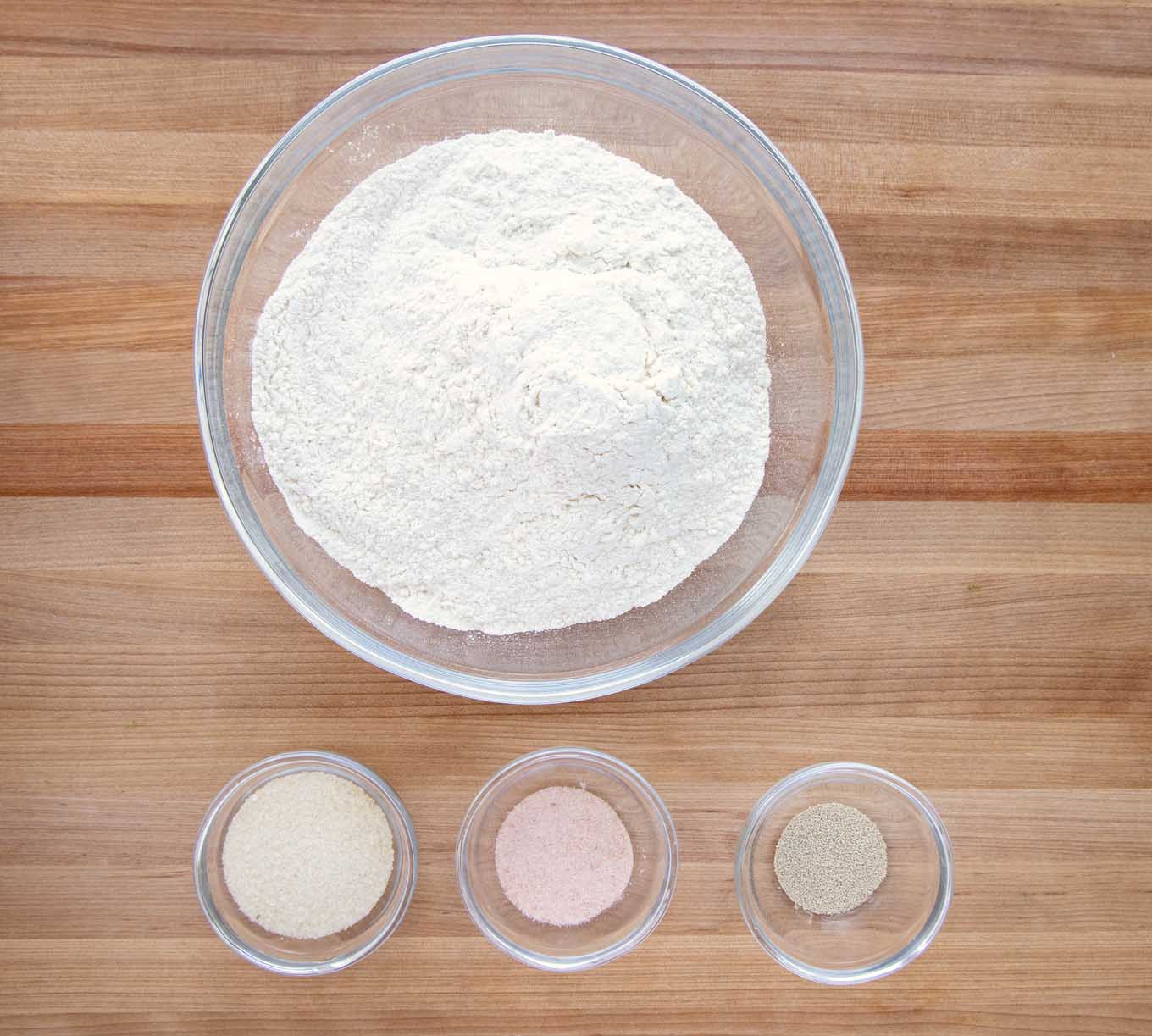
It’s a very short list of ingredients to make this perfect loaf of homemade artisan bread. All-purpose flour, sea salt, yeast, and sugar are the only ingredients you need.
I use Sherpa Pink Himalayan Salt in my kitchen. The other products I use are King Arthur Flour, Active Dry Yeast and Natural Cane Sugar.
Why do I need sugar in my Bread Recipe?
That’s a good question and one I had pondered until I spoke with a master baker about what each ingredient did to make the end result in the bread I wanted.
Sugar has quite a few jobs and provides substantial improvements to yeast bread. It’s not an essential ingredient, but it helps make a better loaf of bread.
- Sugar provides an additional source of food for the yeast. The yeast converts this food to carbon dioxide and alcohol
- Sugar (like salt) enhances the flavor of the bread
- Sugar helps give the crust that golden color we love
- Sugar improves the crumb texture of the bread
- Sugar helps retain moisture in bread and slows down the formation of gluten strands, which helps keep the bread fresher longer
Will sugar make the bread sweet?
That’s a great question, and the answer is no. We are not using enough sugar to make this sweet bread. You won’t even notice it’s in the bread.
Why do I need salt in my homemade bread?
- Salt regulates the rate of yeast activity. It provides a slow and steady rise, which is even more crucial in this semi-no-knead bread. The slower rise gives the yeast time to develop the characteristic bread flavors we love
- Salt also strengthens the gluten structure of bread dough. It keeps the trapped carbon dioxide bubbles from expanding too quickly
- Salt makes bread taste better
How to make Artisan Bread
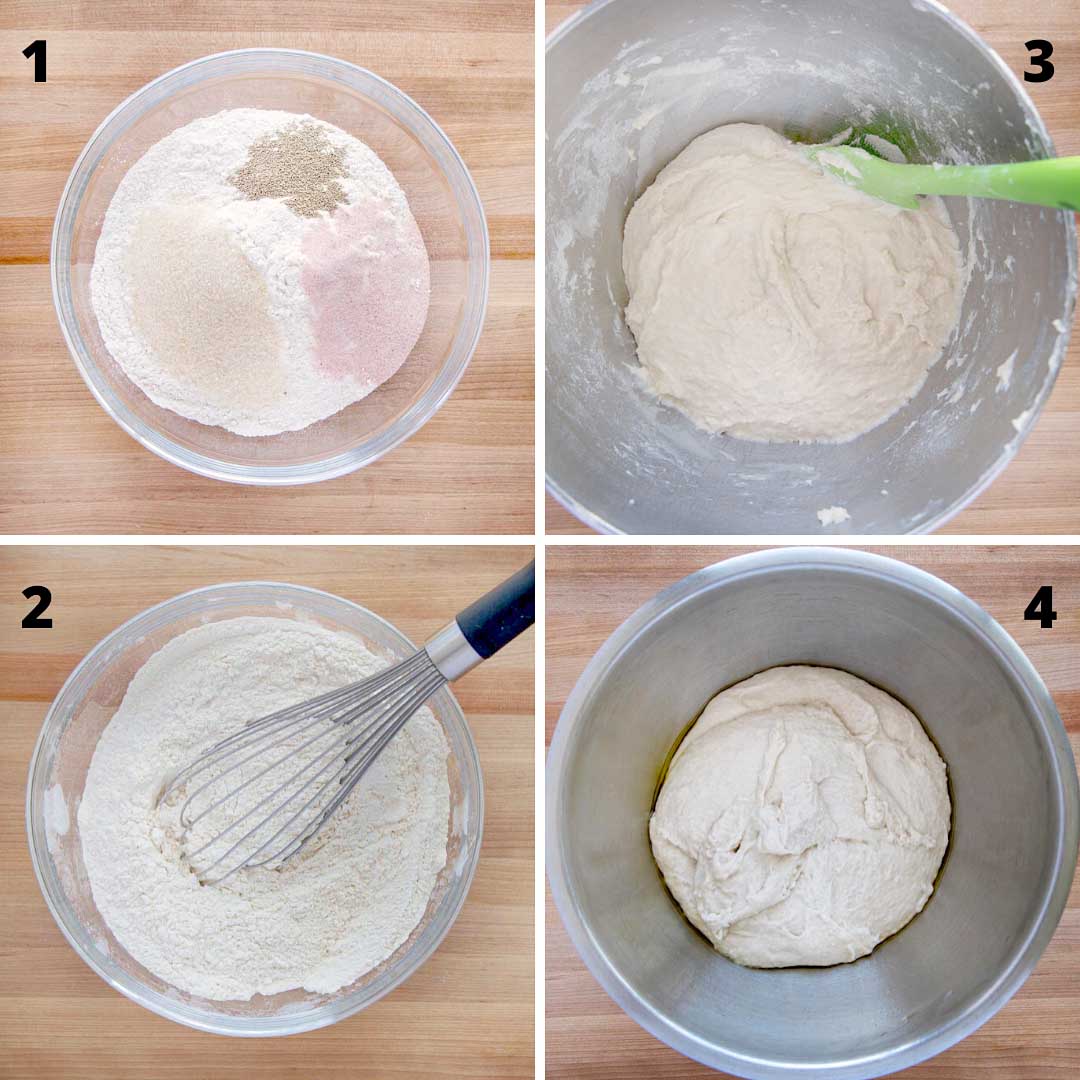
The process is fairly simple. It only takes about 10 minutes to make the bread dough and set it up for the first rise.
Following the recipe, add the salt, sugar, and yeast to the flour, whisking it all together to ensure equal distribution.
Then in a stand mixer (or by hand) add in the water. Depending upon the brand of flour you use, you may need a little less or a little more water. So start with about ¾’s of the water adding more if needed. The dough should be a little wet and sticky.
The last step is to place the bread dough in an oiled bowl and cover it with plastic wrap. Place the bowl on your counter away from drafts for the initial rise.
The rise time will be 12 -16 hours.
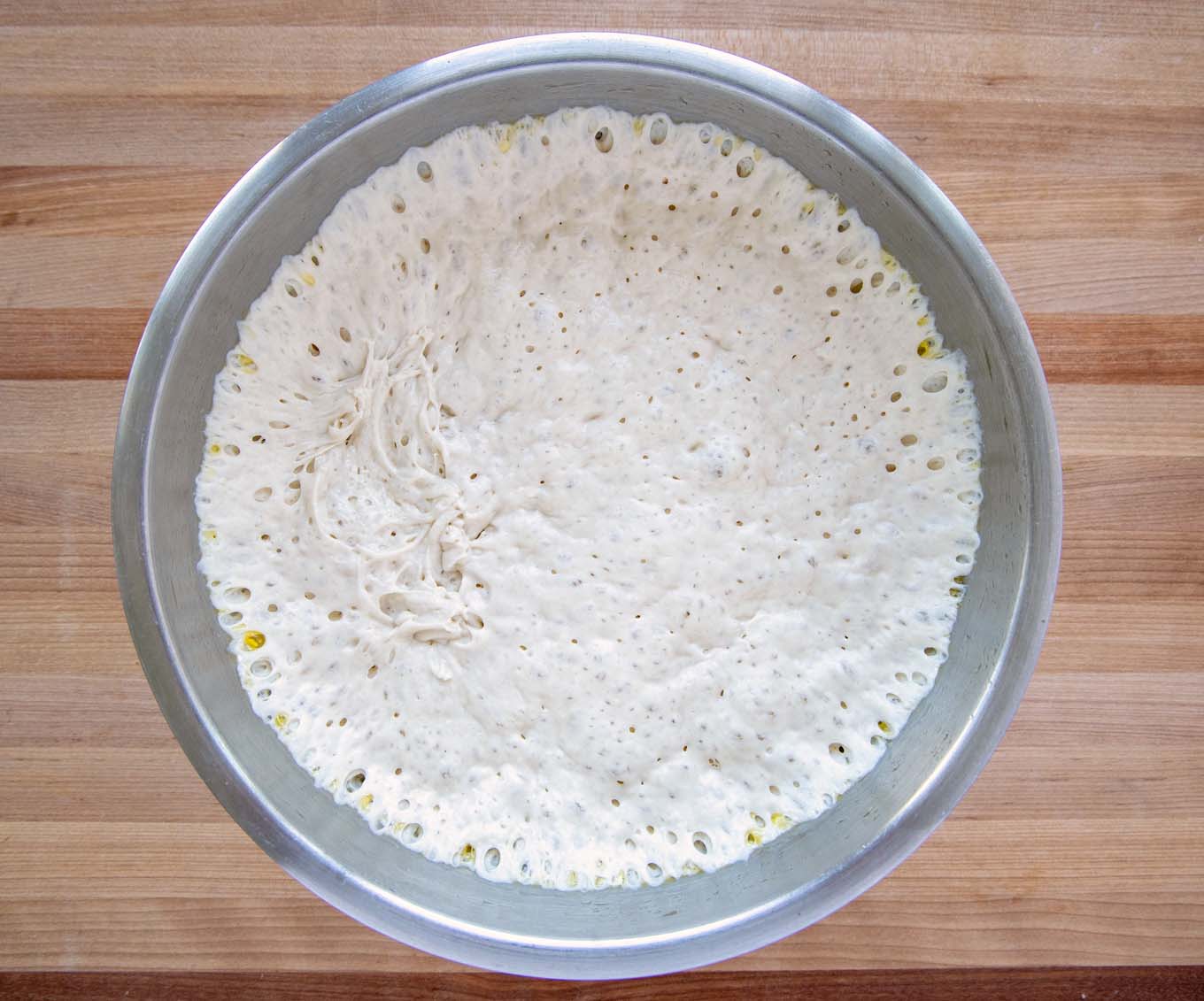
When the first rise is done, the bread dough should look like this. The dough may rise a little more than it falls a little. That’s normal; don’t worry.
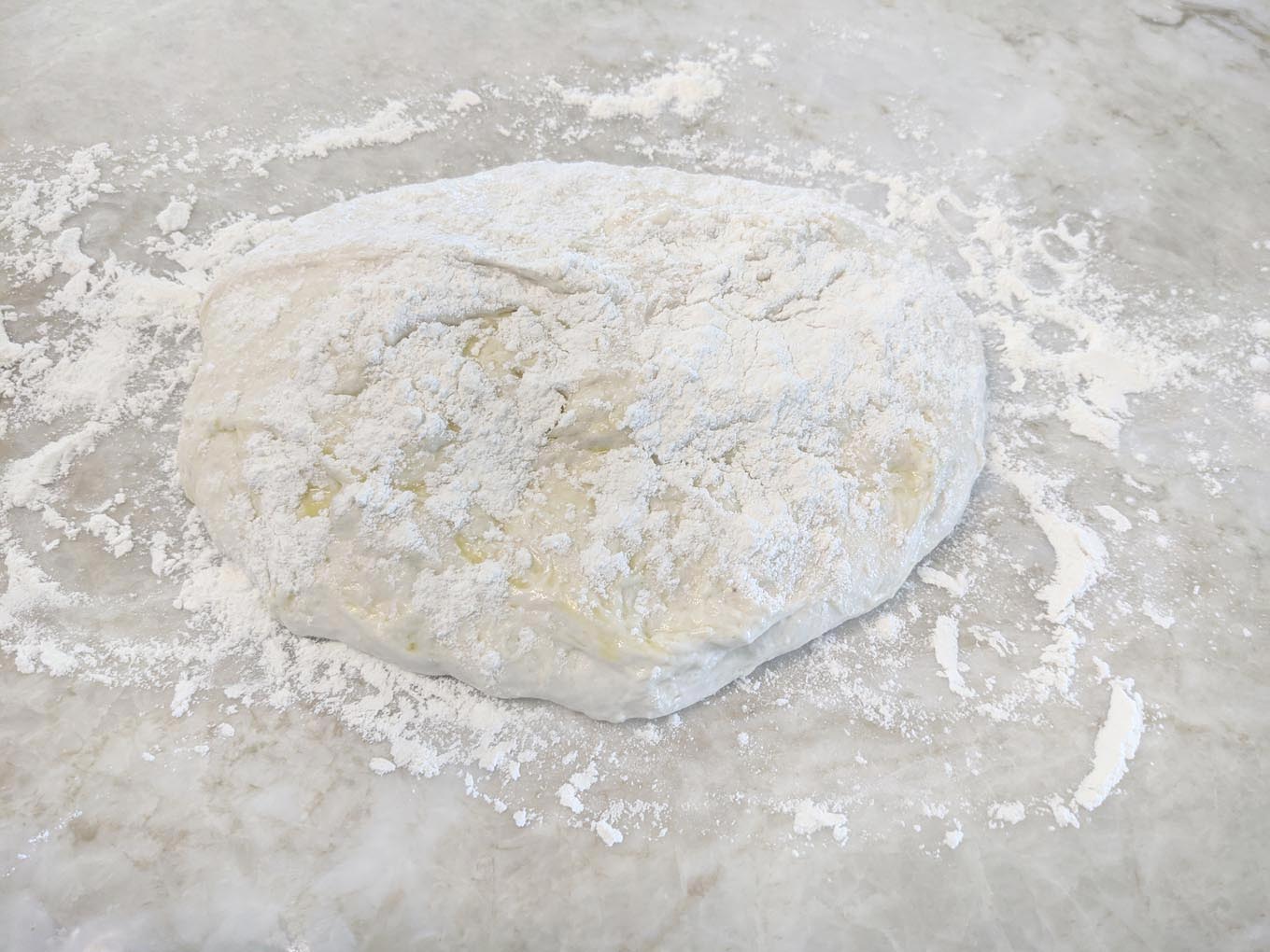
The first step is to lightly flour a countertop and place the bread dough on the floured area. At this point, you will begin adding additional flour until the dough is no longer wet and sticky.
You don’t want the dough completely dry, but it should be easy to work with when you’ve added enough flour. This should take you about 5 minutes.
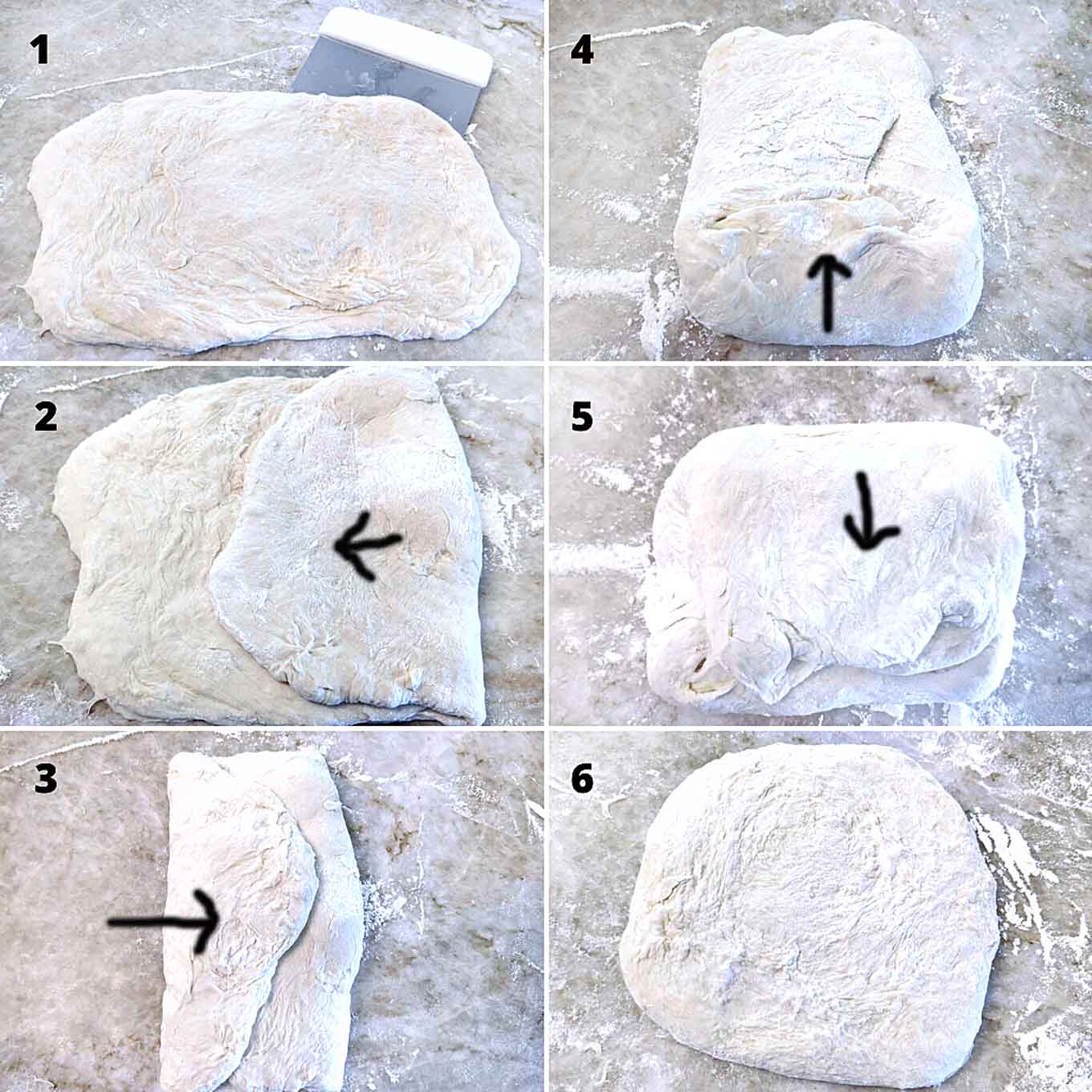
The next steps are the folding process that will give the dough the textures and appearance we want.
- On a floured surface flatten the dough out to make a rectangle
- Fold over ⅓ of the dough to the center (you’re folding the widest part first as shown in the pictures above)
- Fold over the other side of the rectangle overlapping the first fold of the dough
- Continue the folding process by folding the bottom ⅓ of the dough upwards toward the center of the little package you’ve made
- Now fold the top part of the dough down overlapping the fold you just made
- Turn the dough over (seam side down) and make a disc or oblong loaf, depending upon what shape of bread you want to make.
A Dough Scraper or cutter will make the process easier and help move the dough around without constantly touching it.
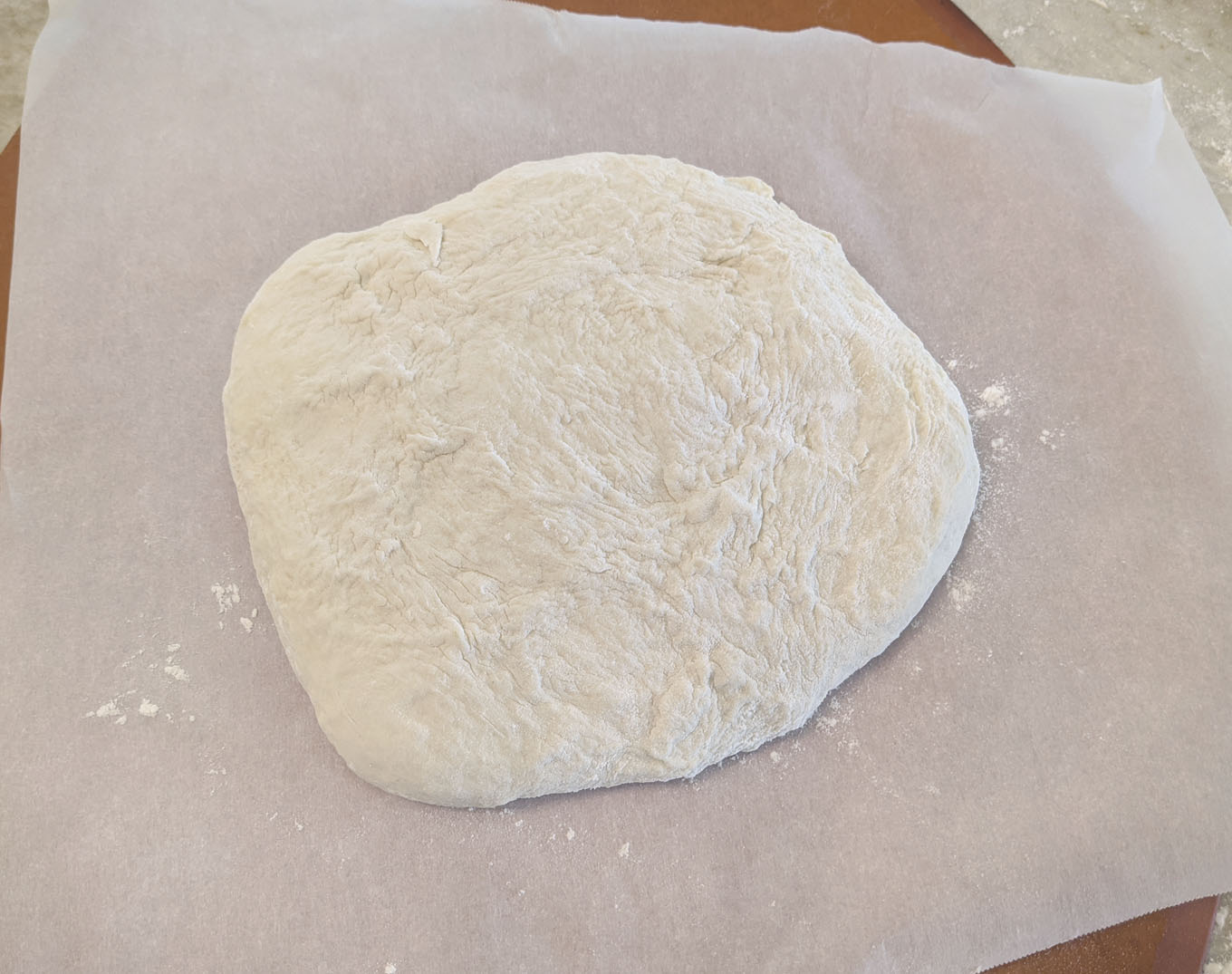
Place the finished dough on parchment paper (sprinkle cornmeal or flour on the parchment before placing the dough)
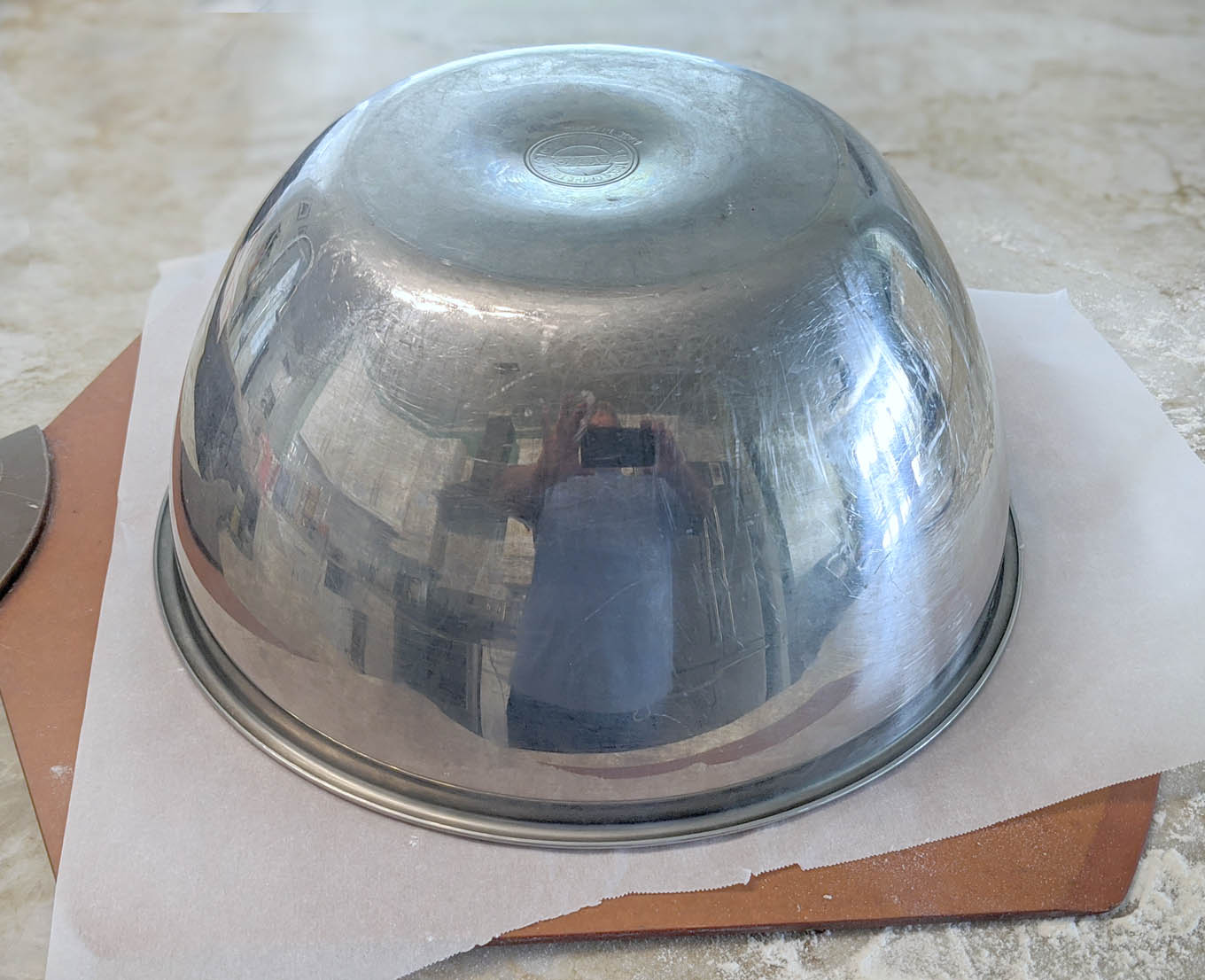
For the second rise, cover the dough with a bowl or damp tea towel. Preheat your oven to 450 degrees F. and place the dough on top of the stove.
The rise time will be 30-40 minutes for the second rise.
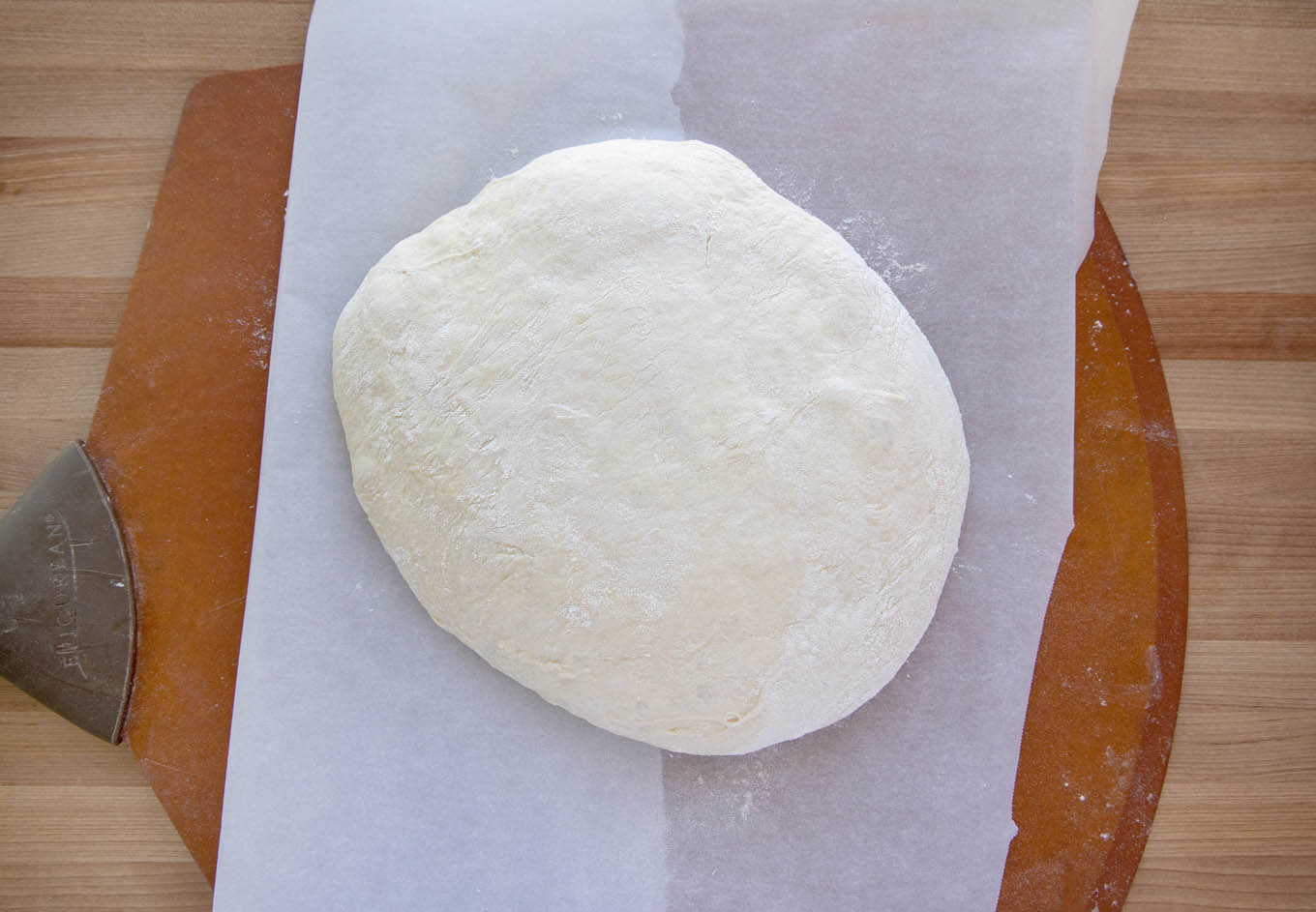
When the bread has finished rising, it should have a pillowy appearance and feel. When you shape the dough, don’t handle it any more than you have to.
The next step is cutting a design (if you want to) on the top of the bread. I used one of my kitchen knives, but they never really make great cuts, so I ordered a Bread Lame and Scoring Tool from Amazon. You don’t really need this, but you know what they say about a boy and his toys.
The last step before placing the bread dough in the oven is to brush it with water. Water helps crisp up the outer crust of the bread, making it crusty, which I love.
- Brush with olive oil for a smooth chewy crust
- Dust the bread with flour for a rustic look and chewy crust
- Brush with melted butter for a softer crust and appearance
- Brush with egg to get a shiny brown crust
**If you want to add seeds to the bread, any of the wet methods will help the seeds stick to the bread.
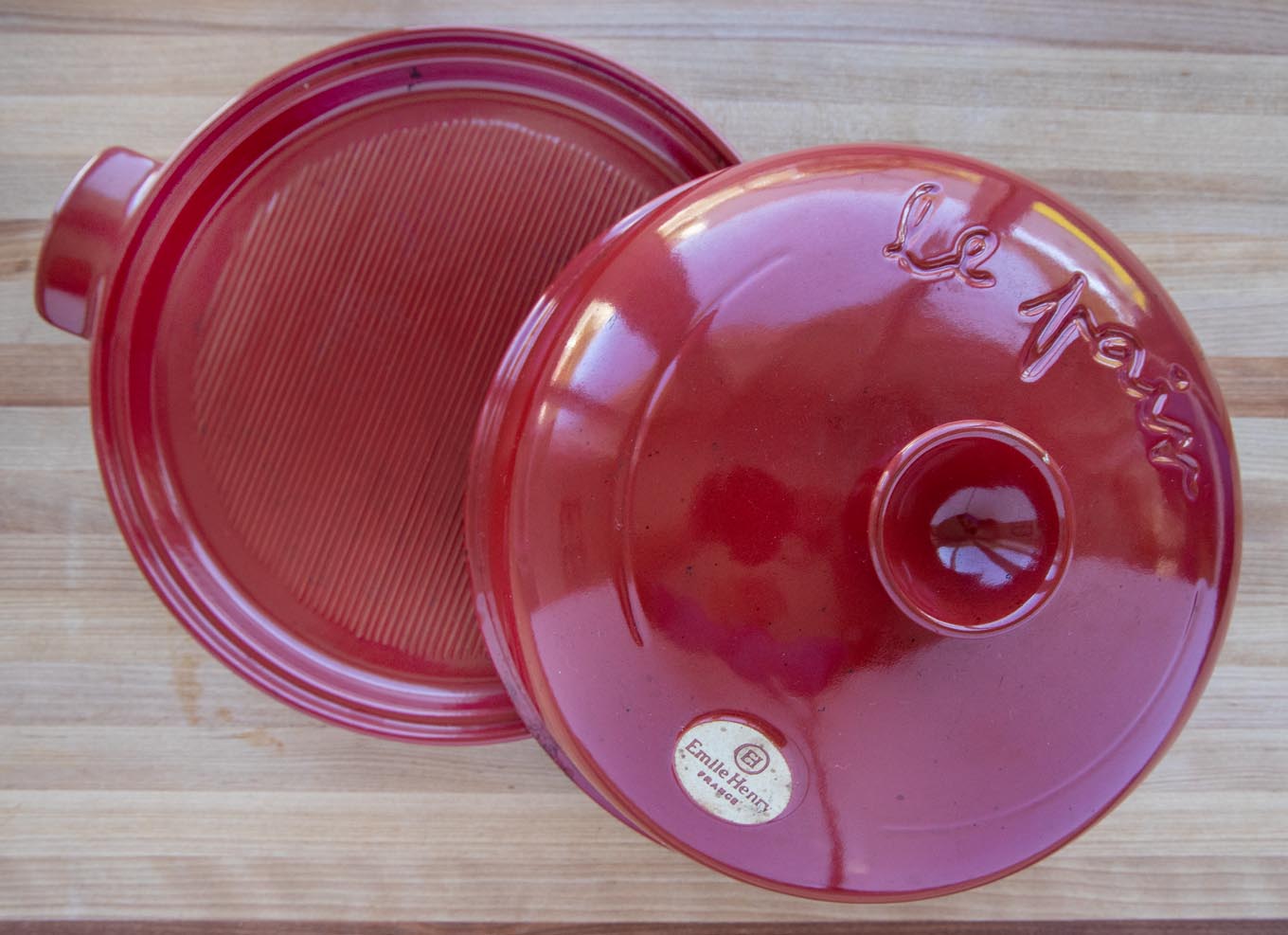
I use an Emile Henry Cloche to bake my bread in. You can also use a Dutch oven for this Artisan Bread.
What size dutch oven should I use to bake this recipe?
To make one loaf from my recipe, you will need a 7 qt. dutch oven or bigger. If you have a 5 qt Dutch oven, you can reduce the recipe by one-third or make two loaves.
What if I don’t have a cloche or a Dutch oven?
If you don’t have a cloche or a Dutch oven, a heavy metal cake pan (round or oblong) will work. If you use a cake pan, you will do your final rise in the pan. The bread will come out a little darker because it won’t be covered.
Recipe FAQ
Bread that is mass-produced using large machines is referred to as Supermarket Bread. Artisan bread is usually made by hand using longer and more traditional processes.
My side-by-side tests showed that my folded no-knead bread had a rounder, more appealing flavor and had a better balance between acid and sweet than the loaves without folds.
The main reason your bread isn’t crusty is moisture, which comes from inside the bread. When cooling, you must give your bread enough room to breathe. Keep your bread on a cooling rack with enough space under it.
after my bread has cooled, I give it 7- 10 minutes and place it directly on the center rack in a 350-degree oven. This crisps the outside of the loaf nicely.
Yes, you can, but not using this recipe. Bread flour has a higher protein count which means the ingredients would have to be adjusted to accommodate using bread flour.

The finished bread is golden brown, crusty, and delicious. Once you get the hang of it, the process will only take minutes.
I keep a ziplock few bags of flour and other ingredients measured out ahead of time. That makes it super easy to make the bread after dinner so it’s ready to bake in the afternoon.


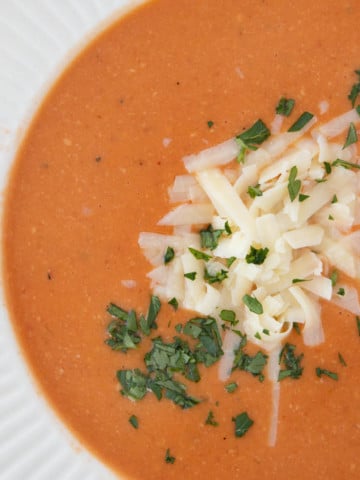
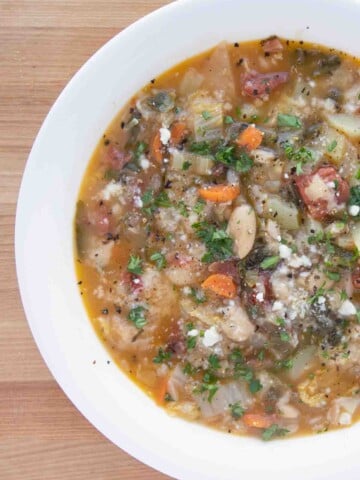
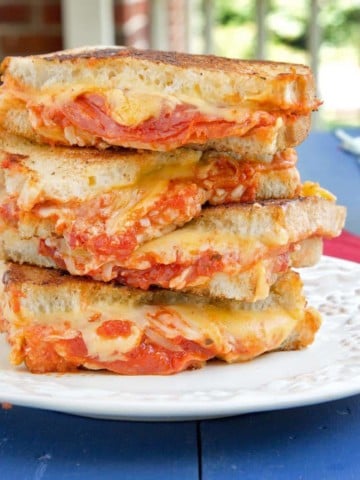
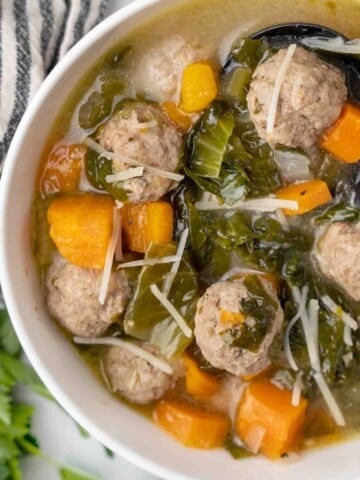
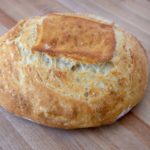

Charlie
Hello Dennis:
I hope that you and yours are fine.
I was wondering why you need sugar in bread.
Also if you go sugarless, why does there have to be a substitute put in for it? Such as sugar twin, aspartame, etc.
Thanks
Charlie
Mariah
Hi Charlie, I just made the recipe without sugar and it turned out great. I don’t prefer sugar in my bread. Try it! 🙂
Angela
Hi Chef Dennis!
Like half the world, I’ve been utilizing this pandemic home time to improve on my baking, and artisan bread has been my Achilles heel. Much to my aggravation, I have been unable to create those amazing holes inside the bread. It always comes out very dense. Flavorful, but heavy. I stumbled on your website and this recipe for your minimum-knead artisan bread and I am very intrigued however I have some questions about timing.
Everything that I’ve researched and subsequently put into practice is to let the bread rise for a minimum of 24 hours up to a week (depending on the recipe) in the refrigerator.
Yet your recipe says to put on the counter for 12-14 hours. I am assuming that the addition of the sugar speeds up the process – hence the shorter rise cycle (none of the other recipes I’ve used included sugar). However with a 12-14 hour cycle, I can’t figure out when to start it so I’m not baking at 2 in the morning or some other ungodly or inconvenient time. Can I put this dough in the refrigerator to rise for 24 hours so I can start it after work on day one and bake it after work on day 2?
Many thanks in advance for your time and advice!
Chef Dennis Littley
Thats the method I use to use for making bread but was never really happy with the results. After watching a video on sourdough I decided to try a new method for making bread combining the slow rise method with the folding of the dough.
I would make the dough sometime in the afternoon or early evening and then bake the bread the bread the next day. I tried refrigerating the dough and it didn’t do well.
Try this method and if it doesn’t provide a better loaf of bread you can always go back to the old techniques. This is the only way I make bread anymore and after a few loaves it becomes automatic and takes no time at all.
Colleen
I’ll be making this recipe this week and I’m wondering if I double it, do I need to simply double the amount of each ingredient. I’ve made no-knead breads for years and I’m very excited to try your version with sugar. Thank you for being so thorough in your directions!
Chef Dennis Littley
yes, just double the amount of each ingredient. I’m very happy with the results this dough makes. There is a little folding of the dough but its still basically no knead
Colleen
Update:
I made this recipe for my family for NYE dinner and it has now become their new favorite. It was a double size loaf that I baked in my large size EH Tagine. My advice, break away from no knead and try this. You won’t be disappointed.
Mazy Walczak
The bread is wonderful and SO easy! Relatively fool proof of you follow the instructions. Eventually I experimented a little and added a whole packet of instant yeast. Additionally I also added about 1/2 cup of my sourdough starter. The result was a bread that was truly irresistible; full of lovely air pockets and impossible to quit eating! I cook mine in a fast iron skillet with parchment paper but no lid. Thanks much for the wonderful recipe!
Chef Dennis Littley
I’m happy to hear that you’ve been enjoying making bread Mazy. It is extremely easy to make. I’m also happy to hear you’ve been experimenting with the recipe, thats when you really start having fun cooking!
Camille
I made this yesterday, and it was a success!! May I ask, after the first rise of the dough, do I add the whole 1/2 cup of flour or gradual? And do I knead it by hand?or just mix it in the dough? I wanted my bread to have more air pockets.
Chef Dennis Littley
add the flour in a little at a time, just enough so the dough isn’t sticky. The initial kneading can be by hand or machine, I use a mixer to get the first blending. I knead the little big for the second rise by hand. Getting more air pockets in this type of bread isn’t always possible, that comes from the interaction of the yeast. You need the area you are proofing the dough in to not be too warm so the rise is a slower process. That’s why I use less yeast and let the first rise go for at least 12 hours. The second rise should be slow also, again not in a hot area.
Stretching and folding the dough can also help create more bubbles, which is why I added that part to my artisan bread recipe.
Hope that helps and the more you make this bread the more you’ll find ways to adjust it.
Jane
Hi! Thank you for sharing your recipe! It’s been very good. Just checking in to be sure… should the bread be covered for the 2nd rise? Thanks again!
Charlie
Mazy:
You used this recipe, added a whole pkg. of yeast without changing the other ingredient measurements, except to add a 1/2 cup of sourdough starter?
Do I have this right?
Elizabeth Kelley
What size of Dutch oven do I need? They come in sizes from 3 qt. To 8 qts!
Chef Dennis Littley
to make one loaf out of the dough in the recipe you would need a 7 qt dutch oven. If you only have a 5 qt, you can easily cut the recipe by 1/3.
Maureen K Cosentino
Darn, I can’t this my cast iron pan with lid (osteoporosis) anymore. Could I cover a pan with foil for a cover?
Maureen K Cosentino
U meant I can’t lift the cast iron pan.
Chef Dennis Littley
sure, it might not be quite the same but it should come out well.
Tina Luebke
I use rapid rise yeast for all my other breads. As you know, yeast is almost impossible to find right now! Can I use rapid rise yeast in this recipe? Thank you.
Chef Dennis Littley
it shouldn’t be a problem, there is very little yeast in this recipe
Jill
Hi .. this looks like a great and easy recipe. Wondering if there a flour substitutes that would give the same result?
i.e. oat flour; coconut flour?
Thanks
Chef Dennis Littley
hi Jill
working with non-gluten flours requires a different method, but not working with those flours, I wouldn’t know where to tell you to begin.
Steph
Can I use my Emile Henry Tagine and get the same (or close to it) results?
Chef Dennis Littley
that should work. I would just foil the top so the heat doesn’t escape.
Alena
I love how you make it look so easy to make such a delicious looking loaf of bread! The step by step pictures are really helpful too.
Sara
Such a helpful guide to making this (almost) no-knead bread! I can’t wait to try it out … those air pockets are everything that I want in bread. Looks and sounds delicious!
Sophie
I love artisan breads. This looks so so good and easy to make. I am adding this to my list of to-do.
Denise
Who can turn down a piece of fresh homemade bread? I know I can’t! I love this easy to follow recipe, thank you for sharing.
Sharon
There is nothing like homemade bread. This artisan bread is perfect alongside soups and stews or even for sandwiches.
Paula Montenegro
There’s certainly nothing better than fresh bread! The smell in the house is priceless. Great post Dennis, very well explained. I will be making this bread soon!